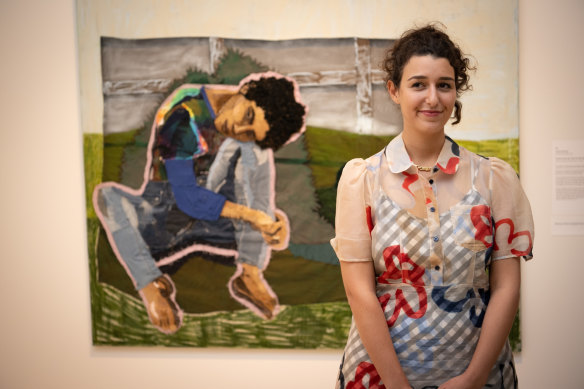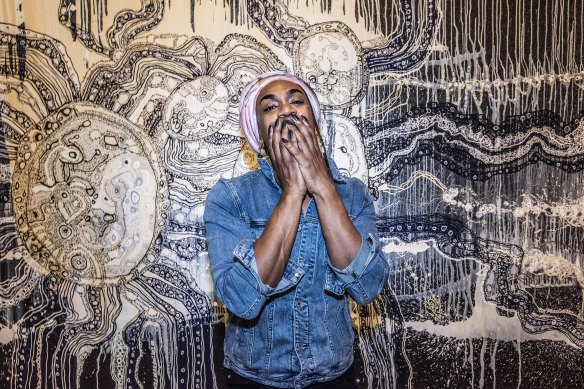This was published 1 year ago
Archibald youthquake? How the young stole old art prizes
This year’s Archibald Prize is a victory for youth. A 29-year-old artist has painted – or rather stitched – a portrait of a 27-year-old pop star. It’s not the worst work in the show, but I wouldn’t have called it the best. My first impression of this year’s selection was that it was exceptionally even and difficult to pick. I eventually thought it might go to Marikit Santiago for a self-portrait with her kids, which seemed to tick the relevant boxes. I only hope I didn’t put the kiss of death on this entry.
Julia Gutman’s Head in the Sky, Feet on the Ground, is the first embroidered Archibald winner. It qualifies as a painting because the background rather than the figure has been painted. It’s also the first time a winner has had a huge patch sliced out of the canvas that reveals the wooden stretcher.

Julia Gutman with her Archibald Prize-winning portrait Head in the Sky, Feet on the Ground.Credit: Wolter Peeters
As a likeness, the portrait is rudimentary because it would require exceptional skill to catch a close resemblance using scraps of discarded clothing. The Art Gallery of NSW trustees obviously decided the artist should get points for trying something different, although it should be noted that contemporary art is enjoying an ongoing love affair with embroidery.
Although trust president David Gonski announced a unanimous decision, one suspects “unanimous” means that once a work has been argued into first place, everybody agrees to give up their personal choices and rally around the flag.
Sulman Prize winner Doris Bush Nungarrayi’s Mamunya ngalyananyi (Monster coming) is an unusual, quirky picture, quite out of character for a Papunya artist, of a colourful array of small critters spread across a black field, quite out of character for a Papunya artist. If there’s such a thing as appealing amateurism, this painting has it.
Zaachariaha Fielding, known chiefly as a singer, was judged the winner of this year’s Wynne Prize for landscape. Fielding’s Inma is a vast swirling composition, as energetic as one of his on-stage appearances. It looks like the aftermath of a wild dance party in which everyone was holding ice creams. In reality, it’s a celebration of a place where children are introduced to vital knowledge.

Winner of the 2023 Wynne Prizem Zaachariaha Fielding with his work, Inma.Credit: Steven Siewert
If we try and break down what is signified by this year’s choice of winners, it’s clear the AGNSW is more determined than ever to market the Archibald and Wynne Prizes as cutting-edge contemporary events. The contradiction is that the 2023 show contains a high percentage of very conservative pictures. One wonders if these artists will be discouraged by this year’s decision, or if they’ll simply keep turning up in the hope of some useful exposure.
With the Wynne, the decision is even more of a statement, as many would have been tempted to give the prize to a painting by John Olsen who died last month, at the age of 95, after a lifetime’s career as an artist. Fielding, in his early 30s, has been painting for three years.
Ultimately, the success and prestige of the Archibald and its associated shows, depends on the audience. If people respond favourably to this year’s youthquake, one might expect a repeat performance. If not?
The organisers may wish to dazzle us with statistics about the newfound inclusiveness of the Prize, but the only statistic that really counts is the number of paying visitors. As this is the one exhibition of the year that many people make a special effort to see, the gallery would have to work overtime to break Sydney of its Archibald habit.
The 2023 Archibald Wynne and Sulman Prizes exhibitions are at the Art Gallery of NSW until September 3.